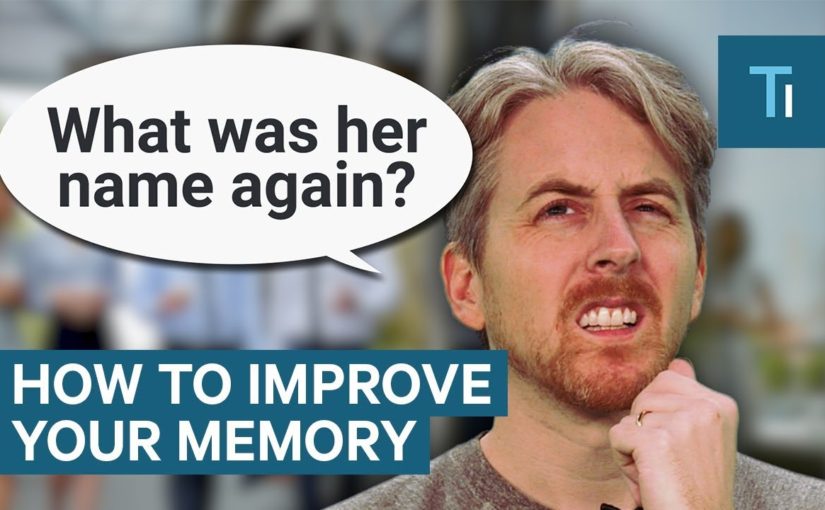00:00:01
– [Jessica] We all wish we were better at remembering something, but many of us use the excuse that– – My brain can only hold so much information. – [Jessica] Or.
00:00:09
– I’m just really bad at remembering names.
00:00:11
– Turns out there’s no such thing as a terrible memory, only an untrained one.
00:00:16
(upbeat music) For a national poll, 800 Americans were asked if they had forgotten one of these things in the last week.
00:00:27
Results showed that forgetting someone’s name was one of the most common memory lapses. – [Man] The biggest reason why we’re bad at remembering names is because we often don’t hear the name. – [Jessica] That is Kevin Horsley.
00:00:38
He is one of the few memory champions in the world to complete the Mt. Everest of memory challenges which involves memorizing 10,000 digits of Pi. – [Kevin] You’ve had this experience before.
00:00:49
You meet someone, and they say their name is John. You don’t hear the name, and just move on. And you come back like, “What was his name again?” Because you actually didn’t hear it in the first place. – [Jessica] 90% of the information we receive is visual, so we store more images in our memory than sounds which makes it harder to recognize and remember names when we first hear them.
00:01:10
– [Kevin] The first thing you have to do is concentrate and make a point of hearing the name, then, you have 20 seconds to give that name some kind of meaning to make it stick. – [Jessica] The best trick to give meaning to a name is to transform it into a silly picture. For example, when you hear the name Horsley, you can picture a horse and Bruce Lee.
00:01:33
For the name Orwig, maybe picture an oar wearing a wig. The more ridiculous looking the image the better. – [Kevin] It sticks in your mind because we don’t remember things that are logical.
00:01:45
We remember things that are illogical. So, what you do is you stick it in your memory in an illogical way, and afterwards you can think about it logically.
00:01:56
– Once you can creatively picture any new information, you’re ready for the next trick.
00:02:01
Horsley calls it by a few names: the Body Method, the Car Method, and the Journey.
00:02:06
– [Kevin] They all work on the same principle that they are all things that are in your long-term memory. You know exactly what your body looks like.
00:02:14
You know exactly what your car looks like. You don’t have to think about it.
00:02:18
– The trick is to imprint new information onto old knowledge.
00:02:22
And what you’re really doing here is creating new synaptic connections in your brain, which makes it easier to remember new information, and then convert into long-term memory.
00:02:31
For example, let’s trying learning all of the films that won the Oscars for Best Picture in the 90s using our body. Let’s start with our feet.
00:02:39
So, in 1990 the film that won Best Picture for that year was Dances with Wolves.
00:02:43
You can picture yourself wearing wolf-shaped slippers and dancing in them.
00:02:48
(upbeat music) Okay, in ’91, Silence of the Lambs won Best Picture, so your knees are knocking together in fear making a lot of noise, so you grab a lamb-shaped pillow to silence them. Moving up your body to your waist.
00:03:04
In ’92, Unforgiven won Best Picture.
00:03:06
So, picture a belt that’s really tight wrapped around your waist.
00:03:10
It’s really uncomfortable and unforgiving. And as you move down the list, you move up your body. Once you have the hang of it, you can use other settings to store, not just lists, but libraries of knowledge. Take a mental journey through your room, or home, to learn all 197 capitals of the world, for example.
00:03:29
– [Kevin] The journey is what all memory champions are using. This method may seem silly, but what it does is it impacts your memory.
00:03:37
So, it’s going to be easier for you to repeat it, then, it’s going to be easier for you to use it, and then, you won’t be thinking about these silly images anymore. – [Jessica] Like anything in life, improving your memory takes practice, but the more you learn, the more connections you can build making it easier to learn even more.
00:03:55
So, the possibilities are endless. Take Horsley, for example, as a child he had issues with dyslexia. By the time he graduated high school, he was reading at a speed of about a five-year-old. Shortly after graduation, however, he got interested in memory. Today, he reads one book a day, speaks three languages fluently, and has earned the coveted title of International Grandmaster of Memory. – [Kevin] For me, it’s been a journey.
00:04:22
I’ve been studying this for almost 30 years, and everyday I’m still learning something new when it comes to memory.
00:04:29
(soft music)



